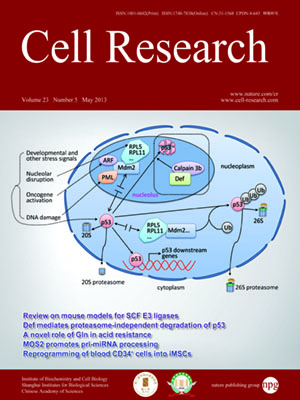
Volume 23, No 5, May 2013
ISSN: 1001-0602
EISSN: 1748-7838 2018
impact factor 17.848*
(Clarivate Analytics, 2019)
Volume 23 Issue 5, May 2013: 658-672
ORIGINAL ARTICLES
Rapid and efficient reprogramming of human fetal and adult blood CD34+ cells into mesenchymal stem cells with a single factor
Xianmei Meng1,*, Rui-Jun Su2,3,*, David J Baylink1, Amanda Neises1, Jason B Kiroyan 1, Wayne Yuk-Wai Lee4, Kimberly J Payne2,3, Daila S Gridley5, Jun Wang6, K-H William Lau7 , Gang Li4 and Xiao-Bing Zhang1
1Division of Regenerative Medicine MC1528B, Department of Medicine, Loma Linda University, Loma Linda, CA 92354, USA
2Division of Anatomy, Loma Linda University, Loma Linda, CA 92354, USA
3Center for Health Disparities and Molecular Medicine, Loma Linda University, Loma Linda, CA 92354, USA
4Stem Cells and Regeneration Program, School of Biomedical Sciences, Department of Orthopaedics and Traumatology, Li Ka Shing Institute of Health Sciences, The Chinese University of Hong Kong, Prince of Wales Hospital, Shatin, Hong Kong SAR, China
5Department of Radiation Medicine, Loma Linda University, Loma Linda, CA 92354, USA
6Department of Pathology, Loma Linda University, Loma Linda, CA 92354, USA
7Musculoskeletal Disease Center, Jerry L Pettis Memorial VA Medical Center, Loma Linda, CA 92354, USA
Correspondence: Xiao-Bing Zhang(xzhang@llu.edu)
The direct conversion of skin cells into somatic stem cells has opened new therapeutic possibilities in regenerative medicine. Here, we show that human induced mesenchymal stem cells (iMSCs) can be efficiently generated from cord blood (CB)- or adult peripheral blood (PB)-CD34+ cells by direct reprogramming with a single factor, OCT4. In the presence of a GSK3 inhibitor, 16% of the OCT4-transduced CD34+ cells are converted into iMSCs within 2 weeks. Efficient direct reprogramming is achieved with both episomal vector-mediated transient OCT4 expression and lentiviral vector-mediated OCT4 transduction. The iMSCs express MSC markers, resemble bone marrow (BM)-MSCs in morphology, and possess in vitro multilineage differentiation capacity, yet have a greater proliferative capacity compared with BM-MSCs. Similar to BM-MSCs, the implanted iMSCs form bone and connective tissues, and are non-tumorigenic in mice. However, BM-MSCs do not, whereas iMSCs do form muscle fibers, indicating a potential functional advantage of iMSCs. In addition, we observed that a high level of OCT4 expression is required for the initial reprogramming and the optimal iMSC self-renewal, while a reduction of OCT4 expression is required for multilineage differentiation. Our method will contribute to the generation of patient-specific iMSCs, which could have applications in regenerative medicine. This discovery may also facilitate the development of strategies for direct conversion of blood cells into other types of cells of clinical importance.
Cell Research (2013) 23:658–672. doi:10.1038/cr.2013.40; published online 12 March 2013
FULL TEXT | PDF
Browse 2417


